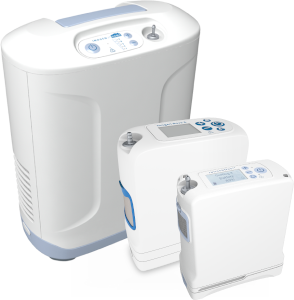What is Transient Nocturnal Desaturation?

Transient nocturnal desaturation, also known as nocturnal hypoxemia, is defined as a temporary drop in oxygen saturation during sleep. Patients diagnosed with sleep disordered breathing from chronic obstructive pulmonary disease (COPD) or obstructive sleep apnea (OSA) are at a greater risk for nocturnal desaturation. A substantial number of patients will have both COPD and OSA.[1]
Transient Nocturnal Desaturation is a significant problem in COPD, affecting a relatively large number of COPD patients. In fact, one study suggests that 27-70% of COPD patients with daytime oxygen saturation levels of 90-95% experience substantial desaturation at night, particularly during a period of sleep known as rapid eye movement (REM) sleep. In people with severe COPD, desaturation during sleep is even more profound than desaturation during exercise, which is also common.[2]
OSA is defined by intermittent collapse of the upper airway, which results in repetitive hypoxemia and arousal. It is estimated that OSA occurs in 4% of American men and 2% of women, meaning almost 10 million people in the United States are affected, although that is probably an underestimate. Obesity is a risk factor for the development of OSA. As obesity rates have risen over the last 15 years, the current prevalence of OSA is almost certainly much greater.[1]
A substantial number of patients will have both OSA and COPD. This “overlap syndrome” causes more severe nocturnal hypoxemia than either disease alone. This common combination of OSA and COPD has important implications for diagnosis, treatment, and outcome.[1]
Causes of Nocturnal Hypoxemia and Desaturation
The primary causes of transient nocturnal desaturation is underlying lung disease and associated co-morbidities, that often lead to the following conditions:[3,4]
-
Hypoventilation – defined as abnormally slow breathing; a common condition found in people with COPD. Often leads to hypoxemia (low blood oxygen levels) and hypercapnia (high blood carbon dioxide levels).
-
Ventilation/perfusion (VQ) mismatch – also common in COPD; occurs when ventilation (the exchange of air between your lungs and the environment) and perfusion (the passage of blood through the lungs) are not equal. V/Q mismatch also leads to hypoxemia and hypercapnia in COPD patients.
Risk Factors and Predictors of Nocturnal Desaturation
There are a variety of potential predictors and risk factors when it comes to nocturnal oxygen desaturation. One study suggests that the only predictor of transient nocturnal desaturation is daytime oxygen saturation levels of less than or equal to 92%.[5] Another study suggests that the best predictor of transient nocturnal desaturation is daytime carbon dioxide levels.[2] Another study found several statistically significant predictors of nocturnal oxygen desaturation in moderate to very severe COPD patients with a normal concentration of oxygen in the blood. These predictors included desaturation during a 6-minute walk test, right atrial/right ventricle dilation on echocardiography and positive c-reactive protein levels, which indicate presence of systemic inflammation, all of which pointed to likely nocturnal hypoxemia in these patients.[6]
Though further study is warranted, there seem to be many predictors and risk factors that can help doctors determine whether a patient should be tested for nocturnal oxygen desaturation.
Diagnosis of Nocturnal Hypoxemia and Desaturation
If you believe you may have nocturnal hypoxemia and oxygen desaturation, you should see your doctor right away. Transient nocturnal desaturation can cause serious problems and, like any hypoxemic condition, can affect your health over time. You may ultimately experience negative changes in your blood vessels, blood pressure, brain health, cardiac function and pulmonary function. Nocturnal desaturation can also be an indication that a chronic health condition, like COPD or pulmonary hypertension, is worsening. If you wake up feeling unusually fatigued and unrefreshed, even after a full night’s sleep, it is time to seek medical attention.[5]
Most COPD patients should be screened for daytime predictors of nocturnal oxygen desaturation if they report signs of nocturnal hypoxemia, including fast and shallow breathing, headaches upon waking, insomnia, excessive daytime sleepiness, rapid heart rate and nightmares.[6]
You will need to be tested for transient nocturnal oxygen desaturation via home oximetry, but your doctor may also request that you undergo a sleep study and an arterial blood gas study to get a complete understanding of the severity of your nocturnal hypoxemia and oxygen desaturation. Even after beginning treatment, you will still undergo some of these tests to continue to monitor your oxygen saturation and to ensure that you do not experience hypercapnia, or a buildup of carbon dioxide in your blood.[5]
To be diagnosed with transient nocturnal desaturation, your normal, daytime oxygen saturation level must drop at least 4% during sleep for at least 5 minutes.[7] Monitoring your oxygen saturation levels at night involves using overnight continuous pulse oximetry. This is a reliable, cost effective tool that automatically monitors and records information about your saturation levels while you sleep.[2] Nocturnal oximetry is recommended to evaluate gas exchange during sleep in COPD patients.[7]
Treatment of Nocturnal Oxygen Desaturation
Although it’s been well-established that daytime hypoxemia is treated with long-term oxygen therapy (LTOT), treatment for transient nocturnal desaturation varies among physicians.[8] Developing a clear understanding of how prevalent nocturnal desaturation is in COPD – in the absence of other respiratory conditions – is an important step towards managing it in a standardized way.[8] Therefore, it is suggested that in the absence of obstructive sleep apnea, supplemental oxygen can be prescribed and patients should then be assessed for improvement in symptoms like quality of sleep, and energy, concentration and focus during the day. As always, supplemental oxygen should be used at the minimum therapeutic level to provide benefits and help prevent nocturnal desaturation.[1]
Treatment for transient nocturnal desaturation in COPD usually involves oxygen therapy, delivered through a nasal cannula or face mask. This treatment can increase the amount of oxygen that you take in as you inhale, which improves your blood oxygen saturation. If your treatment is effective, you may start to notice an improvement in your daytime energy level.[5]
At present, there are two groups of COPD patients that may benefit from the use of oxygen therapy during sleep:
Patients who normally require oxygen therapy during the day because of daytime hypoxemia who experience nocturnal oxygen desaturation during sleep.[5]
Patients who do not have daytime hypoxemia or use oxygen therapy during the day, but who experience a drop in their oxygen saturations when they sleep.[8]
Patients should discuss the convenience of their oxygen delivery device, including whether they can travel with it, as well as the sound level when in operation and the mode of oxygen delivery (i.e. pulse dose versus continuous flow dosing).
Learn How Inogen Can Help
If your doctor prescribes nocturnal oxygen therapy for you, ask about whether an Inogen oxygen concentrator meets your oxygen needs at night. Because we offer both Intelligent Delivery Technology® pulse dosing in our portable oxygen concentrator units and continuous flow dosing in our home oxygen concentrator unit, you have several Inogen options to choose from to help you manage nocturnal hypoxemia and oxygen desaturation effectively.[9]
Inogen oxygen concentrators are designed to be quiet, running at a noise level of 40 decibels or less (on Flow Setting 2 or below), which is about the noise level of a library.[10] Additionally, because our portable oxygen concentrators are designed to be small and lightweight, you can bring your Inogen portable oxygen concentrator with you, even when you travel, to give you peace of mind when outside your home and away from your stationary concentrator.
Inogen offers portable oxygen concentrators with Intelligent Delivery Technology® to help ensure that you get the right oxygen dose for you at the right time. Intelligent Delivery Technology adjusts to your breathing rate, delivering the correct bolus dose for your nocturnal breathing pattern. If your doctor determines that you need continuous flow oxygen, our home oxygen concentrators offer continuous flow dosing to meet your needs.
Find out what kind of oxygen delivery device your doctor recommends for you, then contact Inogen today to find out how we can meet your needs. We look forward to helping you manage your nocturnal desaturation through oxygen therapy at home or away.
References
- Owens RL, Malhotra A. Sleep-disordered breathing and COPD: the overlap syndrome. Respir Care. 2010 Oct;55(10):1333-44; discussion 1344-6. PMID: 20875160; PMCID: PMC3387564.
- Owens RL. Supplemental oxygen needs during sleep. Who benefits? Respir Care. 2013 Jan;58(1):32-47. doi: 10.4187/respcare.01988. PMID: 23271818
- Peters B. What Oxygen Desaturation Index (ODI) Means on a Sleep Study Report. Verywell Health, 3 Jan. 2020, www.verywellhealth.com/oxygen-desaturation-index-3015362.
- Plywaczewski R, et al. Incidence of Nocturnal Desaturation While Breathing Oxygen in COPD Patients Undergoing Long-Term Oxygen Therapy. Chest, vol. 117, no. 3, Mar. 2000, pp. 679–683, doi:10.1378/chest.117.3.679.
- Leader D, COPD Can Make Your Oxygen Levels Drop at Night. Verywell Health, Verywell Health, 29 Jan. 2020, www.verywellhealth.com/transient-nocturnal-desaturation-914932.
- Jackin Moses R and Karthik Narayanan P. Predictors of Nocturnal Oxygen Desaturation in Normoxemic Patients with Moderate to Very Severe Chronic Obstructive Pulmonary Disease. International Journal of Contemporary Medical Research IJCMR, vol. 6, no. 10, Oct. 2019, pp. J1–J5., doi:10.21276/ijcmr.2019.6.10.41.
- Fanfulla F, et al. Sleep Disordered Breathing in Patients With Chronic Obstructive Pulmonary Disease. Minerva Medica, U.S. National Library of Medicine, Aug. 2004, pubmed.ncbi.nlm.nih.gov/15334044/.
- Lacasse Y, et al, Evaluating Nocturnal Oxygen Desaturation in COPD–Revised. Respiratory Medicine, U.S. National Library of Medicine, 10 May 2011, pubmed.ncbi.nlm.nih.gov/21561753/.
- Chatburn, et al. Nocturnal Oxygenation Using a Pulsed-Dose Oxygen-Conserving Device Compared to Continuous Flow; Respiratory Care March 2006 Vol 51 No 3, Nocturnal oxygenation using a pulsed-dose oxygen-conserving device compared to continuous flow – PubMed (nih.gov)
- NoiseBookmarks.pdf_53984ebfeae681.51655891.pdf (audiology.org)











